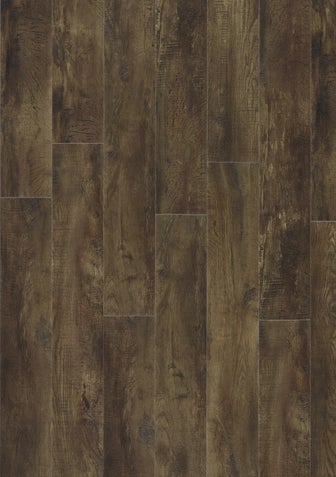LVT & Hybrid Guide
Luxury vinyl tiles or planks, more commonly referred to as LVT or hybrid flooring, replicate timber and stone looks by using advanced technologies. Now your home can have the timeless look of wood or stone at a fraction of the cost. All flooring types have their own pros and cons, and it is up to you to decide what option best fits your home and lifestyle. Here are some characteristics of LVT/hybrid flooring to help you decide if it is the right choice for you.
The basics
Luxury Vinyl Tiles/Planks (LVT/LVP) are made up of multiple layers starting with a base of PVC, topped with a fill layer for thickness and dimensional stability. On top of this a photographic image is placed to replicated the latest trends in wood, ceramic and stone designs. On top of this image, a clear vinyl wear layer is applied to protect the tile or plank for durability. Depending on the variety of LVT that you are looking at, there may be slight differences in the layers making up the flooring. Some manufacturers use more or less layers, or have different protective layers on the top surface to further enhance wear resistance and other features. These vary across the different ranges and can make some LVT superior to others.
Quality
The quality of the top coat wear layer should not be underestimated as this is what makes LVT durable, hardwearing and scratch-resistant. A LVT with a thicker layer, while more expensive, will provide longer resistance to wear-and-tear. Opting for an LVT with a thin top layer, will be cheaper but may not have the lasting quality and appearance. Scratches from debris, furniture moving and human interaction can be avoided by selecting a quality LVT that has a better wear layer. It is always good practice to lift furniture instead of dragging when moving it across your floor and using felt pads on the feet of furniture.
There is a wide variety of qualities of LVT. Some ranges have the texture of wood or stone with grooves and embossing, truly replicating the look and feel of the raw material.
Installation
One of the most appealing features of LVT is the ability to install it in homes without having to remove skirting boards or kickboards from kitchen cabinetry. What’s more is that it can be laid on top of any existing hard flooring. The subfloor must simply be finished well with no dust, dirt, high levels or protruding stones in the concrete. This is so the planks or tiles lay completely flat and don’t have any irregularities show through. It is always a good idea to order slightly more flooring than you need and to store this away somewhere safe. When you come to making any alterations to your home and need to ‘patch’ your floor or you seriously damage a plank, you can remove this and replace it for a seamless repair.
As LVT is glued directly to the subfloor without the use of an underlay, there may not be the desired or required sound absorption levels that can be achieved with other flooring types. This is especially important to note for multilevel homes or apartments where noise travels between floors. The exception to this is in the case of a loose-lay LVT which is thicker and has additional layers that enhance the acoustic properties beyond the standard LVT.
Installation is relatively quick as well so there may be savings in laying LVT over other hard flooring types.
Maintenance & underfloor heating
LVT is an easy care, low maintenance flooring option. It doesn’t need waxing, polishing, sanding or refinishing. Instead, regular mopping and sweeping will maintain its appearance.
Like with any other floor covering, spills on the floor should be attended to briskly to avoid lasting damage. Liquid spills have the potential to lift planks along the edges, particularly the short edges. Water can seep into the seams and ‘washout’ the adhesive. If this does happen and only a few planks are affected, it can be fairly easily remedied.
Dimensional stability is the biggest issue when using luxury vinyl. Gapping or ‘peaking’ where ends of planks butt into each other and stick up, may occur due to environmental and installation factors. This is undesirable as it can make for an unsightly looking floor, as well as result in dirt build-up in the gaps over time. Some LVT ranges are proven to be more stable than others, with extensive testing evidence available on request. Environmental factors are the major cause of this phenomena occurring. Luxury vinyl needs to be acclimatised at the property before being installed. The floor and room temperature also needs to be maintained prior to, during and for some time after installation. It also can’t be installed outside of certain temperature range.
Most LVTs are compatible with underfloor heating systems. To avoid damaging the planks or tiles, there are maximum heat setting recommendations and best practice guides to follow.
LVT in the home
In the kitchen… LVT is a great option for kitchens. It can be installed in existing kitchens without having to remove kickboards or scotia. Dropped food can be cleaned away without mess or fuss.
In the hallway… Perfect for entrance and hallways, LVT will withstand the constant movement and traffic with its hardwearing properties.
In the bedroom… A good choice for bedrooms, LVT will work well in this space. For chilly winter mornings place a sheepskin on the floor at your bedside for something warm to step onto, or an area rug for kids playing on their bedroom floor.
In the bathroom and laundry… Providing the bathroom has good ventilation and temperature ranges do not move outside of recommended conditions, LVT can be used in these spaces.
In the living space… LVT is well suited for lounges and living spaces. Team this with a rug to add texture or warmth if required.











